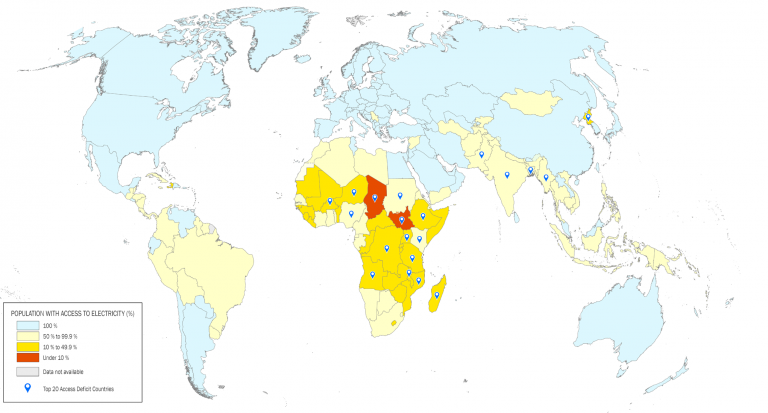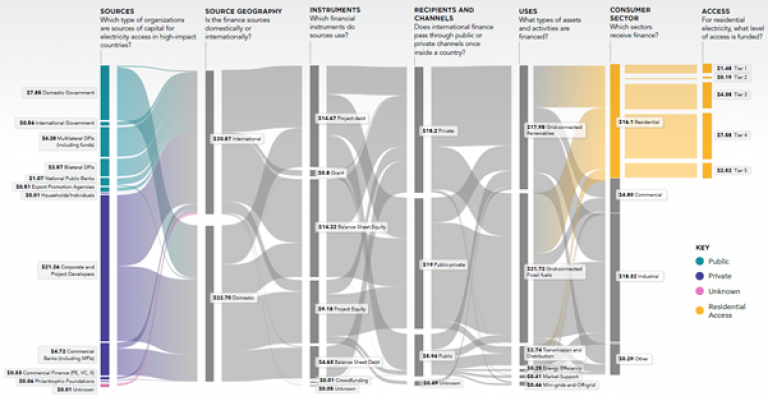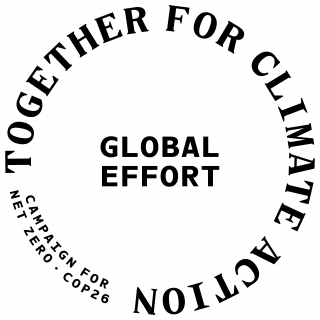Navigating universal energy access for all
19 October 2021

At a glance
- Billions of people all over the world lack access to the energy needed to meet important needs, such as lighting, cooking, health care and the ability to do productive work
- Though some of these are needs are met within the home, some require energy supplied outside of the home
- Interpretation of the energy access target of the seventh Sustainable Development Goal (SDG7) has tended to focus on energy in the home – but this results in a focus on only a small portion of the energy services that must be met to lift people out of poverty
- Access to clean and renewable energy that brings people out of poverty by energising all aspects of a modern economy and society, is what is needed to meet both the needs of this generation, and safeguard the environment for future generations
What is the problem?
A large proportion of the world’s population does not have access to the modern forms of energy needed to prosper in the 21st century, such as reliable electricity (a situation also known as energy poverty). This lack of access – particularly found in Sub-Saharan Africa and parts of Southeast Asia (Figure 1) – prevents people from benefiting from the services and activities many people rely on and take for granted as they go about their daily lives. These services include lighting and clean cooking in the home, health care, transport and the ability to carry out economically productive work.
People who do not have access to forms of modern energy such as electricity are often reliant on ‘traditional’ forms of energy, such as the use of wood fuel for cooking. Whilst such traditional energy use may not be inherently problematic in every case, it can be carried out in a way that is harmful to the people concerned, and to the environment. For example, the unregulated harvesting and burning of wood emits pollutants harmful to human health and to the climate when burned inefficiently – it is estimated to have caused 1.6 million deaths globally in 2017, and to have contributed 1.9-2.3% of global greenhouse gas emissions in 2009.

Figure 1: Share of population with access to electricity in 2019, by country (Source: The Energy Progress Report)
It has been almost a decade since the General Assembly of the United Nations declared the year 2012 as the year of Sustainable Energy for All, in an effort to elevate the attention given to this global problem, and thus channel greater effort to solving it. Despite increasing efforts to tackle this issue, periodic monitoring of progress being made has since shown slow and patchy gains; and current trends suggest that the target set to universally address this issue by 2030 under the Sustainable Development Goals will be missed. This slow progress highlights the difficulty of what is a very complex and varied challenge, both in its nature and the required solutions.
This explainer will focus on a particular characteristic of the issue, but one that has a significant impact on just how far the global community can go in effectively addressing this challenge. It is the problem of shortcomings that exist in how energy poverty is viewed and understood by some leading practitioners. Specifically, the tendency to focus on energy poverty as it manifests at the household level, risks underestimating the equally significant problems of lack of energy access beyond the home.
What are the key characteristics of the problem?
The seventh Sustainable Development Goal (SDG7) is to “ensure access to affordable, reliable, sustainable and modern energy for all”, and the first target of this goal (SDG7.1) is to “by 2030, ensure universal access to affordable, reliable and modern energy services”. In a bid to give greater attention, and channel greater action, to the plight of the energy poor, there has been an increasing desire to shape and categorise this problem at the level of households. The UN has set indicators to measure progress towards the energy access target (SDG7.1) in the form of population proportions with access to modern energy, such as electricity. This use of population proportions as a progress indicator encourages attention to observations at the household (or person count) level alone. Most recent data records this as 759 million people without access to electricity (or approximately 10% of the global population), and 2.6 billion people without access to clean modes of cooking (or 34% of the global population) in 2019.
The focus of the SDG indicators on the household level in turn has the result that the means by which progress is tracked, projections are made, timetables are scheduled, and the end goal is confirmed, all rely on this household measure. Importantly, estimations of the resources required (e.g., finance, technologies) are based on the provision of access to a household, which go on to influence the commitments and investments that are sought, and the policies to enable them.
But a little thought about everyday activities leads to a recognition that the energy needed to thrive in the modern world is a lot more than just household energy. For example, energy is used to power grocery stores, for the procedures for routine and urgent treatment in hospitals, to enhance the educational resources available at schools, and to provide the stability of the many varied services required to get to work and make it productive. It also powers the data centres filled with powerful machinery serving this digital age and the instantaneous services upon which lives increasingly depend.
Lack of access to these types of activities and services is as much a part of poverty as is lack of energy access within the home. In regions plagued with energy poverty at the household level, energy to power the above activities is just as scarce. The separation of energy for household services from energy for non-household services, and the absence of focused attention for the latter in the sustainable development agenda, hinders progress by failing to consider what is in reality a substantial component of energy poverty. The Energy for Growth Hub estimate that if non-household electricity consumption was considered in the estimate of the number of people across the globe that are electricity poor, then close to half the global population would be considered as electricity-poor (3.5 billion), as opposed to the 759 million people currently estimated [1].
Under the indicators used by the UN to characterise universal energy access, the most recent estimate of annual investment needs to meet the 2030 goal (SDG7.1) is US$45.5 billion. Financing needs for energy access that will also address the broader challenge of energy poverty beyond the home will require considerably more. Nevertheless, even of the US$45.5 billion required per year to achieve universal energy access in the home, only US$16.13 billion was mobilised in 2018 for countries that make up two-thirds of the global electrification deficit – the highest figure mobilised since tracking began in 2013 (Figure 2). This illustrates the difficulty in channelling finance to sustainably meet the deployment of these services in the regions that lack them. Since the early months of 2021, the UN has pulled together 30 member states to champion a major advocacy programme (the UN High Level Dialogue on Energy) geared towards concerted action and commitments from all stakeholders for the achievement of SDG7 and net-zero emissions by 2050. Recommendations have been put forward for the various global energy challenges – including energy access – and a number of funding commitments and pledges were announced at a ministerial-level forum in June 2021, and at the High Level Dialogue’s summit in September 2021. The mobilisation of $400 billion in funding commitments at the summit in September to tackle the various aspects of SDG7 – not just SDG7.1 – is a step in the right direction, but remains well short of the levels required. These efforts to encourage coordinated action are part of what is needed to achieve these complex goals. But if – as can be expected – these commitments are being guided by the estimates of financing needs that focus on energy provision at the household level alone, then success would have been hamstrung by a failure of not being ambitious enough. It is estimated that approximately another US$23.4 billion was invested in 2018 for energy to non-residential uses in the most energy-poor regions of the world, but it is unclear how close that figure is to what is required annually if energy that comprehensively eradicates poverty is to be provided.
Figure 2 - 2018 finance flows for electricity access in countries that make up two-thirds of the global electrification deficit (Source: SEforALL)
What is the solution?
Global indicators that track progress towards SDG7 must adopt a more comprehensive definition of energy poverty.
The Energy Progress Report is a periodic report that is used to track progress on the achievement of SDG7. It shows updates on progress primarily in terms of access to energy at the household level. There is a need to also monitor access to energy services beyond the household level. There is also a need to move beyond the reporting of number of people gaining access and the types of systems being used, because – though this is useful information – it is now widely acknowledged that it is not an energy connection that alleviates poverty, but the activity or service it enables.
What is stopping the solution being implemented?
Two impediments to a useful revision of how universal energy access is characterised, monitored, and tackled, come in the areas of data and history.
The collection of data on the useful services enabled by energy consumption across the various sectors of an economy would mark a major shift in the data collection practices of many developing countries. This change would be challenging to implement under the various jurisdictions within a country, let alone the globe. Furthermore, many countries suffering from energy poverty have a large proportion of communities that are informal or rural, which bring their own very specific challenges in data collection and management.
The premise of the attention given to energy access at the household level stems from decades of action in the second half of the 20th century which focused on expanding the energy sectors of developing countries, but gave limited attention to the situation of the poorest populations living in rural and remote locations. In reaction against such programmes, many practitioners now prioritise focus on the progress made in making modern energy available to those who do not have it in their homes.
How can these barriers be removed?
Methods of measuring energy access, which cut across both household and non-household uses, should be developed and enhanced. The World Bank’s Multi-tier Framework for Measuring Energy Access considers access to modern energy available to households, but also productive enterprises, and various types of institutions (e.g. health and education facilities and other public buildings). As such it presents a useful starting point for the selection of improved indicators and the collection of data to monitor progress. Over the past few years surveys making use of the World Bank’s method have been undertaken in various nations, but have primarily been focused on household uses only. These can be expanded to include other sectors, and updated on a periodic basis.
In increasing the attention paid to non-household energy poverty, it is crucial to avoid the approaches of the past that focused on large scale productive economic activities but ignored the plight of the rural poor. The change needed is not to remove the characterisation of energy access at the household level, which enables the development of suitable policies and strategies to address them, but rather to add non-household energy access needs to the characterisation of the goal of universal energy access under SDG7.1. This will enable practitioners to continue to develop the variety of solutions that are suited to various locations at a given point in time, but will importantly allow them to be realistic about what these solutions are achieving in the path to providing everyone with energy access that brings them out of poverty and reduces harm to the environment.
Finally, there is a need to draw lessons from previous negative experiences of uncoordinated donor attempts to provide energy for productive activities. What is required are carefully considered and organised efforts that coordinate the activities of multiple actors and institutions working to provide solutions to modern energy and long-term local development.
Conclusion
The global community has recognised the importance of modern energy to human life and development, and has given it the requisite attention by including the provision of “affordable, reliable, sustainable and modern energy for all” within the Sustainable Development Goals. As governments, international organisations, researchers, civil society and the private sector seek to navigate this mammoth and complex task, there is a need to ensure that their efforts will not be in vain. Energy access to households is important and necessary, but meeting the energy access SDG requires more than enabling households to use light bulbs and charge their mobile phones for 4 hours a day. Access to clean and renewable energy that brings people out of poverty by energising all aspects of a modern economy and society, is what is needed to meet both the needs of this generation, and safeguard the environment for future generations.
In text references
[1] Energy For Growth Hub (2020): https://www.energyforgrowth.org/memo/3-5-billion-people-lack-reliable-power/
 Close
Close



